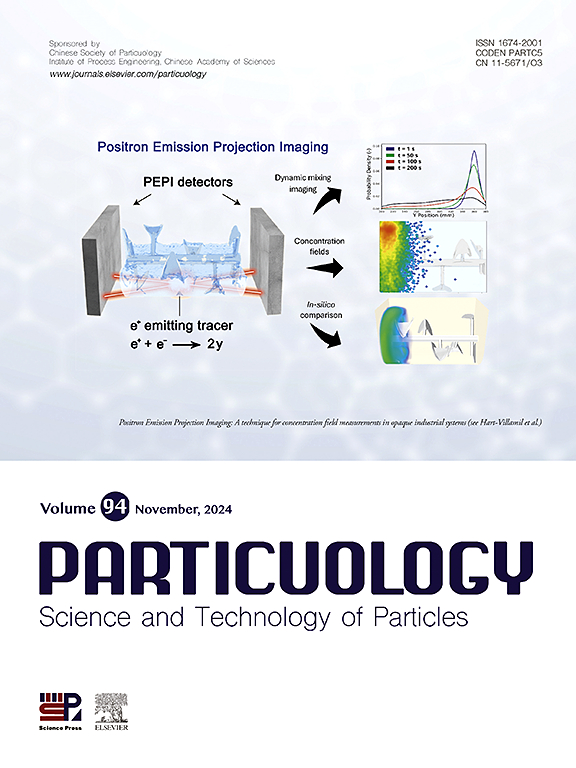Impact of pressure on gas-solid hydrodynamics of Geldart B and D particles in a pressurized bubbling fluidized bed: A CFD-DEM study
IF 4.1
2区 材料科学
Q2 ENGINEERING, CHEMICAL
引用次数: 0
Abstract
Pressurized fluidized beds have gained considerable interest in industrial applications due to their superior performance and efficiency compared to atmospheric fluidized beds. However, the mechanisms through which pressure influences the hydrodynamic behavior of different particle types remain insufficiently explored, hindering the scale-up, optimization, and broader adoption of this technology. To address this gap, CFD-DEM simulations were performed on a pseudo-2D pressurized bubbling fluidized bed using Geldart B and D particles. The effects of pressure, particle size, and initial bed height on key flow characteristics, including minimum fluidization velocity, particle dynamics (i.e., particle velocity and volume fraction distribution), and bubble behavior (i.e., bubble diameter, aspect ratio, density) were comprehensively examined. Results showed that the minimum fluidization velocity decreases with increasing pressure and increases with particle size, with greater sensitivity at lower pressures. Higher pressures lead to smaller bubble diameters, higher bubble aspect ratios, and denser bubble populations, resulting in concentrated particle distribution in the lower bed and more uniform radial dispersion. In contrast, larger particles create fewer, larger bubbles or slugs, and increase the overall bed height. These high-fidelity simulations offer valuable insights for optimizing the performance of pressurized fluidized beds in industrial processes.

压力对加压鼓泡流化床中Geldart B和D颗粒气固流体动力学的影响:CFD-DEM研究
与常压流化床相比,加压流化床由于其优越的性能和效率而在工业应用中获得了相当大的兴趣。然而,压力影响不同颗粒类型流体动力学行为的机制仍未得到充分探索,这阻碍了该技术的规模化、优化和更广泛的应用。为了解决这一问题,利用Geldart B和D颗粒在伪2d加压鼓泡流化床上进行了CFD-DEM模拟。全面考察了压力、粒径和初始床层高度对关键流动特性的影响,包括最小流化速度、颗粒动力学(即颗粒速度和体积分数分布)和气泡行为(即气泡直径、长径比、密度)。结果表明:最小流化速度随压力的增大而减小,随粒径的增大而增大,且在较低压力下敏感性较大;压力越高,气泡直径越小,气泡长径比越大,气泡密度越高,导致颗粒在下床层分布更集中,径向弥散更均匀。相反,较大的颗粒会产生更少、更大的气泡或段塞,并增加整个床层高度。这些高保真模拟为优化工业过程中加压流化床的性能提供了有价值的见解。
本文章由计算机程序翻译,如有差异,请以英文原文为准。
求助全文
约1分钟内获得全文
求助全文
来源期刊

Particuology
工程技术-材料科学:综合
CiteScore
6.70
自引率
2.90%
发文量
1730
审稿时长
32 days
期刊介绍:
The word ‘particuology’ was coined to parallel the discipline for the science and technology of particles.
Particuology is an interdisciplinary journal that publishes frontier research articles and critical reviews on the discovery, formulation and engineering of particulate materials, processes and systems. It especially welcomes contributions utilising advanced theoretical, modelling and measurement methods to enable the discovery and creation of new particulate materials, and the manufacturing of functional particulate-based products, such as sensors.
Papers are handled by Thematic Editors who oversee contributions from specific subject fields. These fields are classified into: Particle Synthesis and Modification; Particle Characterization and Measurement; Granular Systems and Bulk Solids Technology; Fluidization and Particle-Fluid Systems; Aerosols; and Applications of Particle Technology.
Key topics concerning the creation and processing of particulates include:
-Modelling and simulation of particle formation, collective behaviour of particles and systems for particle production over a broad spectrum of length scales
-Mining of experimental data for particle synthesis and surface properties to facilitate the creation of new materials and processes
-Particle design and preparation including controlled response and sensing functionalities in formation, delivery systems and biological systems, etc.
-Experimental and computational methods for visualization and analysis of particulate system.
These topics are broadly relevant to the production of materials, pharmaceuticals and food, and to the conversion of energy resources to fuels and protection of the environment.
 求助内容:
求助内容: 应助结果提醒方式:
应助结果提醒方式:


